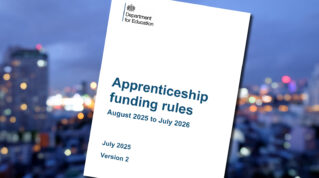Sir Keir Starmer’s pledge last week that a future Labour government will work to ensure vocational training holds the same prestige as academic courses is crucial. But changing people’s attitudes towards vocational routes such as apprenticeships counts for little if apprentices fail to complete their training.
Against the economically tumultuous backdrop of the cost-of-living crisis, an average apprenticeship offers a mere £5.28 an hour. While this number has gradually risen from £4.81 in March 2022, this approximate nine per cent increase does little to support apprentices under pressure from the 16.9 per cent increase in the cost of food and non-alcoholic beverages that occurred in the lead up to December 2022. Apprenticeships are therefore becoming less appealing and in some cases even unsustainable. Many are dropping out to start jobs where the minimum wage is higher.
Last year, and in a throw-back to the target-driven, top-down system of government that became the hallmark of New Labour, then-minister for skills and apprenticeships, Alex Burghart announced an ambitious new 67 per cent target completion rate for apprenticeships.
Despite the target, completion rates continue to go in the wrong direction. Recent figures put them at 53 per cent – down from 58 per cent in 2019/20. Apprenticeship starts have also plummeted by over 160,000 in absolute terms since 2015/16. So, there are fewer going in, and even fewer coming out.
Various factors catalyse low completion rates, but a major factor is undoubtedly the apprenticeship minimum wage. For example, the current £5.28 an hour apprenticeship salary compares poorly to an entry-level hourly wage of £11.02 at Tesco.
Adding fuel to the fire, some employers even fail to pay that. One in five (21 per cent) of the 202 employers named and shamed by the government for breaching minimum wage laws in 2022-23 additionally failed to pay their apprentices the lowest rate.
Last week, the government missed an open goal to incentivise employers to pay more by omitting apprenticeship wages from its annual league table of the ‘top 100 apprenticeship employers’. Thus, with the cost of living spiralling, many apprentices are instead lured away by the prospect of more lucrative work elsewhere.
But while apprentices should be paid more, they must also do all they can to complete their training. Dropouts are hugely frustrating for employers and providers alike. Not only does their hard work go to waste, it also negatively impacts completion rates.
Apprentices are lured away by the prospect of more lucrative work elsewhere
Often, employers are too lenient in granting apprentices leave from their apprenticeship. The learner’s subsequent failure to return to their training is also a driver behind low completion rates. For apprenticeships to hold the same parity of esteem as academic routes, they should be subject to similar expectations in terms of attendance and processes for requesting leave as other educational courses.
Employers and providers must also provide their apprentices with an effective support structure. We have found that providing additional support for our apprentices with issues such as mental health helps to reduce the rate of absence. As a result, we have a lower-than-average dropout rate.
The final issue that deters people from starting and completing apprenticeships is the 12-month minimum duration. Heralded by ministers as a way of introducing greater rigour to the system, the reality is that it’s led to the unnecessary extension of important but low-paid apprenticeships in areas such as hospitality. At the same time, the policy has created the false impression to some businesses that more technical training can be completed in 12 months.
The duration of apprenticeships should be less uniform and instead adapted to the needs of the industry’s technical requirements and those of the skill itself.
There is no silver bullet to addressing the high apprenticeship dropout rate. Instead, the solution requires a coordinated effort by government, employers, providers and learners alike.
Whoever is in power, we’ll have to go way beyond a 67 per cent completion rate before we can even begin to talk about the long dreamed-of parity of esteem. But by having a wholesale review of pay, conditions and minimum duration periods, and by introducing a greater support structure for learners, I’m confident this goal is an achievable one.

















An interesting hypothesis on the reason for poor achievement rates, much of which I agree with.
I would add that employers need to go further than just pay. They need to provide proper, dedicated support to apprentices. The rationale for apprentices in the business should be the development of talent, not as I see all too often, maximising levy spend.
Until the excessively bureaucratic funding rules and overly burdensome apprenticeship service account is truly simplified then we will continue to see declining numbers. Those in the sector see this everyday but those that govern think the resolution is simply providing more ‘white space’ in the funding rules. Really?
Govt have cut our digital apprenticeship funding by 20% which is madness. Combined with 10% inflation and decreasing employer engagement = very bad news for a national skills strategy already in disarray.
I’m not sure I understand the comparison between apprentice hourly wage though: if the apprentice is aged 16-18 then surely the wage that they are paid as an apprentice in year 1 is exactly the same as what they would earn in another job, as the NMW for that age group is identical?
As under 18’s must be in some form of part-time education, which apprenticeship programs provide, then in theory they couldn’t be taking on on a full-time job at Tesco and be paid at the over 23’s rate anyway.
Oh, and don’t forget that the achievement rate methodology isn’t fit for for purpose.
The transition to standards, the outcome data lag at EPA, widely differing durations, Covid ripples, the displacement of achievement of those past planned end – just a few reasons why it doesn’t work.
The education sector is obsessed with %’s but blindly thinking low is bad and high is good is too simplistic.
For instance, university grade inflation. Looks like this year is the first year in over a decade when grades haven’t inflated and probably only because universities were told to stop grade inflation (note the correlation with the introduction of fees…).
Stagnant productivity, ever worsening social mobility metrics at a time when we’ve never had so many highly educated individuals, on paper.
There are many ways to improve completion rates, but we would be wise to focus on the meaningful ones!